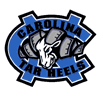|
|
HOME ~ College Football History |
Why
"Tar Heels"?
University of North Carolina athletic teams are known as the Tar Heels
because North Carolina is "The Tar Heel State."
One legend has the nickname being applied to the state's residents as
long ago as the Revolutionary War. According to this story, the troops
of British General Cornwallis were fording what is now known as the Tar
River between Rocky
 Mount and Battleboro when they discovered that tar
had been dumped into the stream to impede their crossing. When they
finally got across the river they found their feet completely black with
tar. Their observation that anyone who waded North Carolina rivers would
acquire tar heels led to the nickname first being used. Mount and Battleboro when they discovered that tar
had been dumped into the stream to impede their crossing. When they
finally got across the river they found their feet completely black with
tar. Their observation that anyone who waded North Carolina rivers would
acquire tar heels led to the nickname first being used.
Others say the nickname was acquired during the War Between the States.
During one of that war's fiercest battles a column supporting North
Carolina troops was driven from the field. After the battle, the North
Carolinians who had successfully fought it out alone, happened to meet
the regiment which had fled to safety and were greeted with the
question, "Any more tar down in the Old North State, boys?"
"No, not a bit," shot back one of the North Carolina soldiers. "Old
Jeff's bought it all up," he went on, referring to Jefferson Davis,
President of the Confederacy.
"Is that so? What's he going to do with it?"
"He's going to put it on you'ns heels to make you stick better in the
next fight."
Upon hearing of the incident, Robert E. Lee smiled and said to a fellow
officer, "God bless the Tar Heel boys."
A letter found in 1991 by State Archivist David Olson lends credence to
another more direct theory. A letter from Maj. Joseph Engelhard
describes a fight involving men from North Carolina in which Lee was
heard to have said, "There they stand as if they have tar on their
heels."
The letter, dated August 24, 1864, told the tale of a battle on the
outskirts of Petersburg, Va. Engelhard was elected secretary of state
for North Carolina in 1876.
The adoption of light blue and white as UNC's colors dates back to the
19th Century. When the University reopened following the Civil War, most
social activities were directed by two literary societies, the Dialectic
and Philanthropic. The official color of the Di was light blue and that
of the Phi white. Since society membership was compulsory for all
students, the opinions and activities of these organizations were by
nature of circumstances all embracing. It was the custom for all men
from localities west of Chapel Hill to affiliate with the Di and
generally for students from the east to become members of the Phi.
On public occasions the student officers, marshals and ball managers
were chosen equally from the membership of the two societies. It had
long been the custom of each society for its members to wear its color
on such occasions. However, the chief marshal and chief ball manager,
one from the Di and the other from the Phi, wore combination light blue
and white regalias and rosettes signifying that they represented the
whole student body.
Later, when intercollegiate athletics were established, the question of
what to wear became a problem. Certainly, the students wanted to be
associated with the University, but the school had no official colors.
So it seemed only natural for the fans to adorn themselves with the same
combination as that used by the chief marshals and ball managers, colors
which represented not membership in a society, but a University student
body.
Home Page 
|

 Mount and Battleboro when they discovered that tar
had been dumped into the stream to impede their crossing. When they
finally got across the river they found their feet completely black with
tar. Their observation that anyone who waded North Carolina rivers would
acquire tar heels led to the nickname first being used.
Mount and Battleboro when they discovered that tar
had been dumped into the stream to impede their crossing. When they
finally got across the river they found their feet completely black with
tar. Their observation that anyone who waded North Carolina rivers would
acquire tar heels led to the nickname first being used.